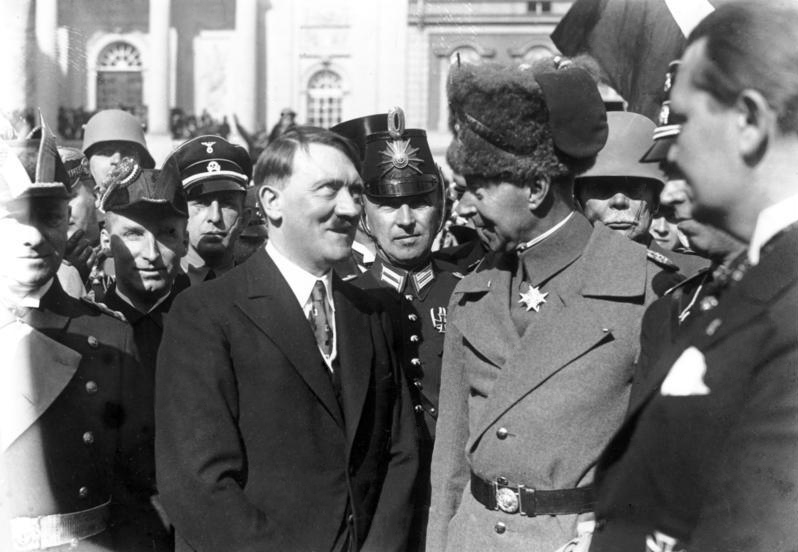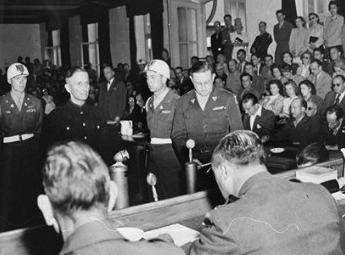|
Former German Nobility In The Nazi Party
Beginning in 1925, some members of higher levels of the German nobility joined the Nazi Party, registered by their title, date of birth, NSDAP Party registration number, and date of joining the Nazi Party, from the registration of their first prince (Ernst) into NSDAP in 1928, until the end of World War II in 1945. Following Kaiser Wilhelm II's abdication and the German Revolution, all German nobility as a legally defined class was abolished. On promulgation of the Weimar Constitution on 11 September 1919, all such Germans were declared equal before the law.Article 109 of the Weimar Constitution constitutes: ''Adelsbezeichnungen gelten nur als Teil des Namens und dürfen nicht mehr verliehen werden'' ("Noble names are only recognised as part of the surname and may no longer be granted"). There were 22 heads of these former federal states, titled as the 4 Kings of Germany; Prussia, Bavaria, Saxony, and Württemberg, there were also 6 Grand Dukes, 5 Dukes, and 7 Princes, who along ... [...More Info...] [...Related Items...] OR: [Wikipedia] [Google] [Baidu] |
Bundesarchiv Bild 102-14437, Tag Von Potsdam, Adolf Hitler, Kronprinz Wilhelm
The German Federal Archives or Bundesarchiv (BArch) (german: Bundesarchiv) are the National Archives of Germany. They were established at the current location in Koblenz in 1952. They are subordinated to the Federal Commissioner for Culture and the Media (Claudia Roth since 2021) under the German Chancellery, and before 1998, to the Federal Ministry of the Interior (Germany), Federal Ministry of the Interior. On 6 December 2008, the Archives donated 100,000 photos to the public, by making them accessible via Wikimedia Commons. History The federal archive for institutions and authorities in Germany, the first precursor to the present-day Federal Archives, was established in Potsdam, Brandenburg in 1919, a later date than in other European countries. This national archive documented German government dating from the founding of the North German Confederation in 1867. It also included material from the older German Confederation and the Imperial Chamber Court. The oldest documents i ... [...More Info...] [...Related Items...] OR: [Wikipedia] [Google] [Baidu] |
Hitler
Adolf Hitler (; 20 April 188930 April 1945) was an Austrian-born German politician who was dictator of Germany from 1933 until his death in 1945. He rose to power as the leader of the Nazi Party, becoming the chancellor in 1933 and then taking the title of in 1934. During his dictatorship, he initiated World War II in Europe by invading Poland on 1 September 1939. He was closely involved in military operations throughout the war and was central to the perpetration of the Holocaust: the genocide of about six million Jews and millions of other victims. Hitler was born in Braunau am Inn in Austria-Hungary and was raised near Linz. He lived in Vienna later in the first decade of the 1900s and moved to Germany in 1913. He was decorated during his service in the German Army in World War I. In 1919, he joined the German Workers' Party (DAP), the precursor of the Nazi Party, and was appointed leader of the Nazi Party in 1921. In 1923, he attempted to seize governmental ... [...More Info...] [...Related Items...] OR: [Wikipedia] [Google] [Baidu] |
Joseph Goebbels
Paul Joseph Goebbels (; 29 October 1897 – 1 May 1945) was a German Nazi politician who was the ''Gauleiter'' (district leader) of Berlin, chief propagandist for the Nazi Party, and then Reich Minister of Propaganda from 1933 to 1945. He was one of Adolf Hitler's closest and most devoted acolytes, known for his skills in public speaking and his deeply virulent antisemitism, which was evident in his publicly voiced views. He advocated progressively harsher discrimination, including the extermination of the Jews in the Holocaust. Goebbels, who aspired to be an author, obtained a Doctor of Philology degree from the University of Heidelberg in 1921. He joined the Nazi Party in 1924, and worked with Gregor Strasser in its northern branch. He was appointed ''Gauleiter'' of Berlin in 1926, where he began to take an interest in the use of propaganda to promote the party and its programme. After the Nazis came to power in 1933, Goebbels's Propaganda Ministry quickly gained a ... [...More Info...] [...Related Items...] OR: [Wikipedia] [Google] [Baidu] |
Josias, Hereditary Prince Of Waldeck And Pyrmont
Josias, Hereditary Prince of Waldeck and Pyrmont (german: Josias Georg Wilhelm Adolf Erbprinz zu Waldeck und Pyrmont) (13 May 1896 – 30 November 1967) was the heir apparent to the throne of the Principality of Waldeck and Pyrmont and a general in the SS. From 1946 until his death, he was the head of the Princely House of Waldeck and Pyrmont. After World War II, he was sentenced to life in prison at the Buchenwald Trial (later commuted to 20 years) for his part in the "common plan" to violate the Laws and Usages of War in connection with prisoners of war held at Buchenwald concentration camp, but was released after serving about three years in prison. Early years He was born in Arolsen at the ruling family's castle, the eldest son and heir of Prince Friedrich of Waldeck and Pyrmont and his consort Princess Bathildis of Schaumburg-Lippe. He was the nephew of William II, King of Württemberg, and Emma of Waldeck and Pyrmont, Queen Regent of the Netherlands. He was also a ... [...More Info...] [...Related Items...] OR: [Wikipedia] [Google] [Baidu] |
Obergruppenführer
' (, "senior group leader") was a paramilitary rank in Nazi Germany that was first created in 1932 as a rank of the ''Sturmabteilung'' (SA) and adopted by the ''Schutzstaffel'' (SS) one year later. Until April 1942, it was the highest commissioned SS rank after only ''Reichsführer-SS''. Translated as "senior group leader", the rank of ''Obergruppenführer'' was senior to '' Gruppenführer''. A similarly named rank of ''Untergruppenführer'' existed in the SA from 1929 to 1930 and as a title until 1933. In April 1942, the new rank of ''SS-Oberst-Gruppenführer'' was created which was above ''Obergruppenführer'' and below ''Reichsführer-SS''. Creation and history The rank of ''Obergruppenführer'' was created in 1932 by Ernst Röhm and was intended as a seniormost rank of the Nazi stormtroopers for use by Röhm and his top SA generals. In its initial concept, the rank was intended to be held by members of the ''Oberste SA-Führung'' (Supreme SA Command) and also by veteran c ... [...More Info...] [...Related Items...] OR: [Wikipedia] [Google] [Baidu] |
Lippe
Lippe () is a ''Kreis'' (district) in the east of North Rhine-Westphalia, Germany. Neighboring districts are Herford, Minden-Lübbecke, Höxter, Paderborn, Gütersloh, and district-free Bielefeld, which forms the region Ostwestfalen-Lippe. The district of Lippe is named after the Lords of Lippe, who originally lived on the river Lippe and founded Lippstadt there, and their Principality of Lippe. It was a state within the Holy Roman Empire and retained statehood until 1947, when it became a district of North Rhine-Westphalia. History The Lippe district nearly covers the same area as the historic county of Lippe. The first mention of this country was in 1123; it grew in power slowly in the following centuries. In 1528 it became a county, in 1789 it was elevated to a principality. Unlike many other countries of the Holy Roman Empire in the area, Lippe kept its independence in the Napoleonic era, and thus wasn't incorporated into Prussia afterwards. It was one of the smaller memb ... [...More Info...] [...Related Items...] OR: [Wikipedia] [Google] [Baidu] |
Hesse-Nassau
The Province of Hesse-Nassau () was a province of the Kingdom of Prussia from 1868 to 1918, then a province of the Free State of Prussia until 1944. Hesse-Nassau was created as a consequence of the Austro-Prussian War of 1866 by combining the previously independent Hesse-Kassel (or Hesse-Cassel), the Duchy of Nassau, the Free City of Frankfurt, areas gained from the Kingdom of Bavaria, and areas gained from the Grand Duchy of Hesse (including part of the former Landgraviate of Hesse-Homburg from Hesse-Darmstadt). These regions were combined to form the province Hesse-Nassau in 1868 with its capital in Kassel and redivided into two administrative regions: Kassel and Wiesbaden. The largest part of the province surrounded the province of Upper Hesse in the Grand Duchy of Hesse (People's State of Hesse from 1918). On 1 April 1929, the Free State of Waldeck became a part of Hesse-Nassau after a popular vote, becoming part of the Kassel administrative region. In 1935, the Nazi govern ... [...More Info...] [...Related Items...] OR: [Wikipedia] [Google] [Baidu] |
Prinzenerlass
''Prinzenerlass'' (, "princes decree", also spelled Prinzenerlaß) was the name of a 1940 decree issued by Adolf Hitler that prohibited members of Germany's formerly reigning houses from participating in any military operations in the Wehrmacht. In May 1940, Prince Wilhelm of Prussia, the grandson of Kaiser Wilhelm II, took part in the invasion of France. He was wounded during the fighting in Valenciennes and died in a field hospital in Nivelles on 26 May 1940. His funeral service was held at the Church of Peace, and he was buried in the Hohenzollern family mausoleum in the Antique Temple in Sanssouci Park. The service drew over 50,000 mourners. His death and the ensuing sympathy of the German public toward a member of the imperial family greatly bothered Hitler, and he began to see the Hohenzollerns as a threat to his power. Shortly afterwards, the ''Prinzenerlass'' was issued, and all members of the former German royal houses were relieved from combat duties. The decree pr ... [...More Info...] [...Related Items...] OR: [Wikipedia] [Google] [Baidu] |
Wehrmacht
The ''Wehrmacht'' (, ) were the unified armed forces of Nazi Germany from 1935 to 1945. It consisted of the ''Heer'' (army), the ''Kriegsmarine'' (navy) and the ''Luftwaffe'' (air force). The designation "''Wehrmacht''" replaced the previously used term and was the manifestation of the Nazi regime's efforts to rearm Germany to a greater extent than the Treaty of Versailles permitted. After the Nazi rise to power in 1933, one of Adolf Hitler's most overt and audacious moves was to establish the ''Wehrmacht'', a modern offensively-capable armed force, fulfilling the Nazi régime's long-term goals of regaining lost territory as well as gaining new territory and dominating its neighbours. This required the reinstatement of conscription and massive investment and defense spending on the arms industry. The ''Wehrmacht'' formed the heart of Germany's politico-military power. In the early part of the Second World War, the ''Wehrmacht'' employed combined arms tactics (close-cover ... [...More Info...] [...Related Items...] OR: [Wikipedia] [Google] [Baidu] |
List Of German Monarchs In 1918
The term German Empire (''Deutsches Kaiserreich'') commonly refers to Germany, from its foundation as a unified nation-state on 18 January 1871, until the abdication of its last Kaiser, Wilhelm II, on November 9, 1918. Germans, when referring to the Reich in this period under the Kaisers, 1871 to 1918, typically use the term ''Kaiserreich''.''Harper's magazine, Volume 63''. Pp. 593. While the term ''Reich'' does not literally connote an empire as has been commonly assumed by English-speaking people, the term ''Kaiserreich'' literally denotes an empire - particularly a hereditary empire led by a literal emperor, though ''Reich'' has been used in German to denote the Roman Empire because it had a weak hereditary tradition. In the case of the German Empire, the official name ''Deutsches Reich'' is properly translated as "German Realm"; under its constitution the King of Prussia, as head of state, officially "presidency, presided" over a confederation of German states, and held "the ti ... [...More Info...] [...Related Items...] OR: [Wikipedia] [Google] [Baidu] |





